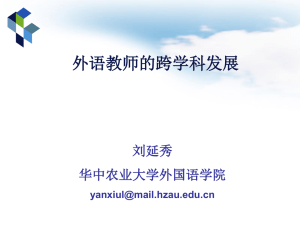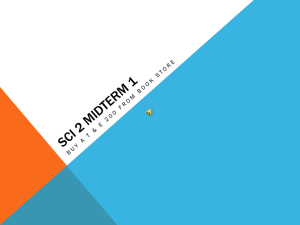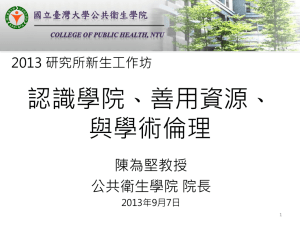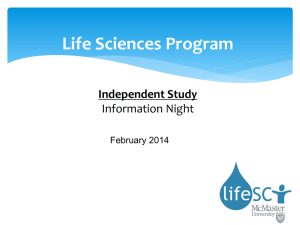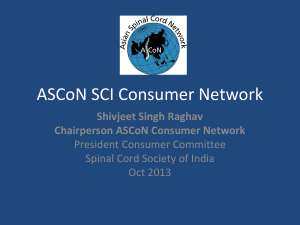PPT by Dr Jagdish Arora
advertisement
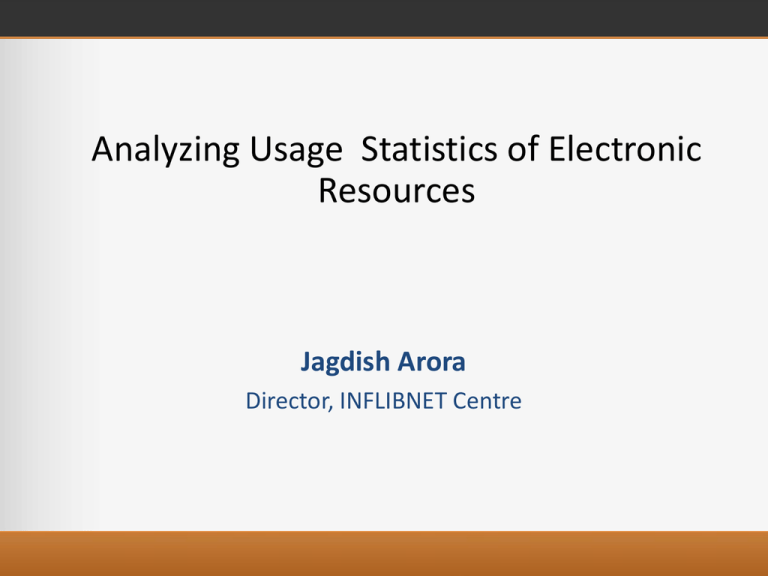
Analyzing Usage Statistics of Electronic Resources Jagdish Arora Director, INFLIBNET Centre Not everything that counts can be measured. Not everything that can be measured counts. – Einstein Why do we measure Usage? Usage statistics provide essential evidence: • for extent of usage of e-resources • to showcase the trends in usage over a period of time, Patterns of usage can be helpful guide for future collection development decisions • to take informed decisions regarding renewal / cancellation of resources • to demonstrate value for money / return on investment Why Collect Usage Statistics? • To make best and justified use of financial resources • Calculating Return on Investment (RoI) • Accountability • To find out emerging subject disciplines • Reporting usage to administration, funding agencies, etc. • Strategic planning • Comparison with other libraries / institutions Why Collect Usage Statistics? • Justifications for change in document format – – – – From print to electronics Lesser number of users visiting library physically Lesser no. of books being issued / Less re-shelving Increase in usage of e-resources • Bench Marking – Top-cited journals available in e-format as compare to other libraries – Results of usage of e-resources by existing libraries can serve as a bench mark for other libraries Why Collect Usage Statistics?: Additional Information • Journals that are used heavily • Journals not being used at all • Number of denials in case of limit of simultaneous usage • Preference for formats: PDF, HTML • Breach of license agreement: Heady downloads or systematic downloads; How to handle it? Acquiring Usage Statistics • Content Provider (Publishers / Database Vendors) – Some publisher do not provide usage data (eg. MathSciNet, ISID, etc.) – Data inadequate and inconsistent – Data retained on the publisher’s web site only – Inconsistency in usage not reflected – Server caching not reflected What do libraries want from usage data? • Reliable usage Report in consistent format • Usage at journals titles level • Usage by subject area • Analyse trends over time • Ready access for reporting • Evidence of value for money • Benchmarking (comparative usage) Adding More Value • Cost-benefit analysis and RoI • Impact of usage on research output • Benchmarking Why Evaluate at the Consortia Level? Evaluation is Necessary • Negotiation for renewal • Cost / Benefit analysis Evaluation is Possible • Relativity • Comparability • Generalizibility Why Evaluate at the Consortia Level ? Review of current & prospective contracts • Continuing price escalation not sustainable • Evaluate prices to consortia and members • Review contracts with additional criteria • Promote models for quality not just quantity • Plan for future Problems with Manual Collection of Usage Statistics • The usage statistics has to be gathered manually from different publishers • Each publisher has – Different formats for data and delivery – Different access methods – Different availability dates • Cost has to be calculated separately • Data needs to be cleaned up and aggregated manually • It is a labor-intensive and cumbersome process prone to data loss and errors Harvesting Usage Statistics using SUSHI • Automated import of consortia stats • Consortium can track statistics for each member • Data can be retrieved across a series of dates, e.g. period of months • Member logins are pre-populated • The library can access all COUNTER compliant usage stats across their serials holdings • The library can obtain a top level view of their most and least-viewed publishers and titles Negotiate More Effectively • With COUNTER-compliant costs-per-view in hand, negotiate with publishers to realize more realistic cost models • Uncover previously hidden cost information • Utilize consortium-wide data to negotiate optimal terms for the group as a whole • Obtain a better understanding of our consortium members’ usage patterns and collection needs INFLIBNET Usage Portal Benefits of Portal for Usage • Usage statistics for every e-journal package for every member institutions is automatically collected • Consortia-wide data readily available to the whole group for analysis and reporting • The usage data can be exposed completely or partially to member institutions / consortium Administrators Consortium Usage Analysis 12765817 Increase in Number of Fulltext Downlaoads 14000000 6000000 4000000 2000000 4687776 7479060 8000000 6093511 10000000 3153628 No of Downloads 12000000 0 2007 2008 2009 Year 2010 2011 No of Downloads 14000 900 Thousands Cost Incurred Millions Cost Incurred Vs Downloads 800 12000 10000 No of Downloads 600 8000 500 6000 400 300 4000 200 2000 100 0 0 2011 2010 2009 Year 2008 Expenditure on Subscription in Rs. 700 Cost Incurred vs Cost Recovered (2008 - 2011) 12000 Amount in Rs. Millions Cost Recovered Cost Incurred 10000 8000 6000 4000 2000 0 2011 2010 2009 Year 2008 Average Cost per Download (Year wise) 2.5 2 Cost in USD 1.5 1 2.06 1.81 1.35 0.5 1.19 1.14 2010 2011 0 2007 2008 2009 Cost Incurred vs Cost Recovered in 2011 Increase in Usage of JSTOR for Core Members 2500000 140 Usage No of Univ 116 2000000 120 105 100 1500000 80 64 64 60 1000000 40 34 500000 20 0 0 2007 2008 2009 2010 2011 Average Cost per Download for JSTOR & Consortium 2.50 J-Stor Consortium 2.00 1.50 1.00 0.50 0.00 2006 2007 2008 2009 2010 2011 Increase in No of Members for JSTOR 2008 - 2012 250 Associate member Core member 200 150 100 50 0 2008 2009 2010 2011 2012 Usage Trend Analysis for a Single Publisher (ACS) Year-wise Download for ACS (2007 - 2012) 1600000 1400000 1000000 800000 600000 1196487 1398741 0 1031237 200000 594960 400000 560506 No of Downloads 1200000 2007 2008 2009 2010 2011 Year Top Ten Journals of ACS in 2011 Sl. No. Journal Name Number of Downloads 1 Journal of the American Chemical Society 194693 2 The Journal of Organic Chemistry 149561 3 Organic Letters 90272 4 Journal of Medicinal Chemistry 84866 5 Inorganic Chemistry 83202 6 Chemical Reviews 65255 7 Langmuir 58367 8 The Journal of Physical Chemistry B 57635 9 The Journal of Physical Chemistry C 56186 10 Journal of Agricultural and Food Chemistry 49706 MEASURING RESEARCH OUTPUT AND IMPACT OF E-RESOURCES Measuring Research Output The Science Citation Index (SCI), Social Science Citation Index (SSCI) and Arts and Humanities Index (A&HI) are internationally recognized database that works as a filtering mechanism as it indexes qualitative research output from selected journals. The source articles appeared in three indices for 50 firstphase universities of the Consortium was searched in blocks of five years from 1975 to 20010 with an aim to compare the research output in the last block year, i.e. 2005 – 2009. A un-precedental increase in research productivity in terms of number of research articles is evident during 2005-2009 as compared to previous block of five years, i.e. 1975-1979 to 2000-2004. Increase in no. of articles in past 35 Years (In block of Five Years) 45000 40000 Increase in No. of Articles 1975-1979 to 1980-84: 22.97% 35000 2000-2004 to 2005-2009: 76.59% No. of Articles 30000 25000 AHCI SSCI 20000 SCI 15000 10000 5000 0 Blocks of Five Years Correlation Usage Vs. Publishing Output 5000 4500 4000 Number of Publications 3500 3000 2500 2000 1500 1000 500 0 0 500000 1000000 1500000 2000000 Number of Downloads Pearson’s Ranks order Coefficient Correlation = 0.75 2500000 Usage analysis for A Single Institution Does this institution need Complete Collection or Selected Subject Collections Subjectwise Analysis of OUP for AMU 10000 70 66 Total Downloads 60 Average Downloads No of Titles 1000 50 100 26 20 12 8 7 8 106 176 12 87 12 7 14 25 292 576 259 514 18 10 30 10 5 1 1 Biological Science Computer Science & Mathematics Economics Humanities Law Subject Category Library and Information Science 0 Medical Science Social Science No of Titles 7008 40 2571 Downloads 47 1 5 9 13 17 21 25 29 33 37 41 45 49 53 57 61 65 69 73 77 81 85 89 93 97 101 105 109 113 117 121 125 129 133 137 141 145 149 153 157 161 165 169 173 177 181 185 189 193 197 % of Downloads No. of Titles Fulfilling the User needs of the Library 120 100 80 60 40 20 0 No of Titles Title with Highest Download in Each Subject 1800 1665 1600 1400 1200 1000 899 800 600 400 204 200 83 20 34 8 Law Library and Information Science 66 0 Biological Science Computer Science & Mathematics Economics Humanities Medical Science Social Science Correlation Usage Vs. Publishing Output Banaras Hind University 1000 900 y = 0.0017x + 292.81 R² = 0.9596 Number of Publications 800 700 600 500 400 300 200 100 0 0 50000 100000 150000 200000 250000 300000 350000 Number of Downloads Pearson’s Ranks order Coefficient Correlation = 0.98 400000 Banaras Hindu University Annual Average Growth Rate Engg & Technol 5.00% 4.00% A&H 3.00% Agr Sci 2.00% 1.00% 0.00% Social Sci Med & H Sci -1.00% -2.00% Sc Mis & SI Biolog Sci Phy Sci Chem Sci Banaras Hindu University Relative Specialization Index Engg & Technol -0.9975 A&H -0.9980 Agr Sci -0.9985 -0.9990 Social Sci -0.9995 Med & H Sci -1.0000 Sc Mis & SI Biolog Sci Phy Sci Chem Sci Banaras Hindu University 100000000 6000 10000000 5000 1000000 4000 100000 10000 3000 1000 2000 100 1000 10 1 0 World India BHU Contribution of BHU as Compared to the World and India’s Total Publications Engg & Technol A&H Agr Sci 3557 1829 Social Sci 5286 57 Med & H Sci BHU 416 958 1278 Sc Mis & SI Biolog Sci 4422 Phy Sci 3337 Chem Sci Publications Output of BHU 14.00 12.00 Engg & Technol Real Average Citation 10.00 Agr Sci Med & H Sci 8.00 Biolog Sci Chem Sci 6.00 Phy Sci 4.00 Sc Mis & SI Social Sci 2.00 -20.00% A&H 0.00 0.00% 20.00% 40.00% 60.00% 80.00% 100.00% Cited Rate BHU’s Citation Impact in Nine Subject Areas 0 200 400 600 800 Gastroenterology Hepatology Public Environmental Occupational Health Agriculture Business Economics Cell Biology Computer Science Surgery Environmental Sciences Ecology Oncology Pharmacology Pharmacy Biochemistry Molecular Biology Engineering Chemistry 1 India World 10 100 1000 10000 100000 1000000 Banaras Hindu University Contribution of BHU to the World’s Most Productive Areas of Research


